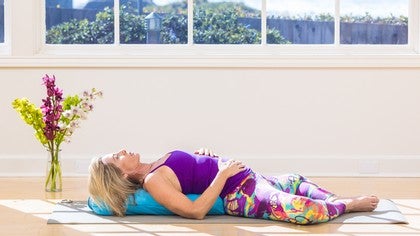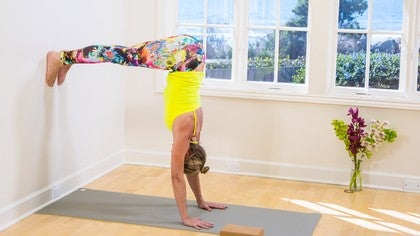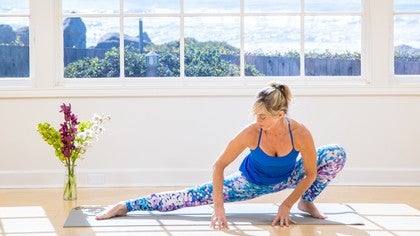Description
Transcript
Read Full Transcript
(relaxing waves) Namaste. So this practice I use in the morning when I first wake up. The first thing I do before I get out of bed is I lie there with my head on the pillow. Sometimes I take my head off the pillow, so I'm flat, and I put my right hand on my belly and my left hand about rib cage heart, and I'll show you in a minute. I watch my breathing and the reason I do this is usually in the morning, that's if I've slept well, it's the best opportunity to feel what the breath, what I'd like the breath to be like throughout the day.
So, that whatever it is that I'm faced with during the day, I attempt to return, to invite the breath to come back to this breath. If I haven't slept well, then I'll know it. Or if I've got something going on emotionally, I'll know it by paying attention to my breathing. And this way I can eliminate, through drawing attention to, I can eliminate some of the issues that might be arising in my body. Sometimes they arise in my body before I'm even aware that they're going on in my mind or emotionally.
So, I will lie down on the bolster and we'll watch me breathe first. And then, if you'd like to try I promise you this is a really great exercise. Okay, so here's what we'll do, if you have a bolster, it's helpful to have. If you don't have a bolster, you can certainly do this on a bed or flat on the floor. If you do have some kind of pillow, be sure that it's relatively even so that you're not left to right heavy.
So, I'm gonna take my hips, my pelvis right up against the bolster and I like to have the soles of my feet together, knees wide apart. I slowly make my way down. You might decide that you wanna have the legs long, which is fine. (inhales and exhales) Slide the blades down low and let the shoulders relax, and at first you gotta let the outside of the body soften and relax. And so I'll take one hand to my belly and the other one a little bit top chest just so I can feel the whole breathing apparatus, in one time.
One thing you wanna check if you have a bolster, be sure that you can rest your elbows down. Okay, so I'm just kind of listening to my breath. And what I'm listening for is the length of the inhale and the exhale. So if I've been stressed or I've got a lot of anxiety, I tend to, I tend to, we're all a little bit different, but I tend to have a longer inhale than exhale. Let's say I wanna control things or make things a certain way, so that inhale is like pulling in, right?
And sometimes the exhale releasing, relaxing is a little more difficult. So I'm checking that. (exhales) Good and then I want for this exercise really to breath in and out through my nose. And for some of us who are newer to yoga that can become a challenge so be just patience with it. Invite it.
And then as you begin to relax, you'll see that, wow the breathe begins to expand and lengthen. (exhales) Some of the early text talk about that we only have so many breaths in our lifetime. We don't actually know how many and so that we wanna breathe slowly, and conscientiously. And whether that's a metaphor or actually true, is something we don't know, but slow and conscience absolutely works because it creates stability emotionally. (exhales) Now, just check your belly and see if the belly is expanding on the inhale.
(inhales and exhales) And then just see if you can have the breath go completely into the belly only. (inhales and exhales) And try it again. (inhales and exhales) And we'll move both hands to the rib cage for a moment, and we're gonna try to expand just the rib cage like a barrel that's expanding. (inhales and exhales) Wanna kind of feel as though your fingers are spreading wide. (inhales and exhales) Try one more.
(inhales and exhales) Good and then don't worry if nothing's happening or you can't quite find that area, that's totally fine it's just wanna know, oh wow, check it out, that area's not working so well this morning. Then we take the hands to the top chest, really high around the collarbone area. Now, attempt to breathe just to the top chest. (inhaling and exhaling) Good, so at this point we've been through the three areas and we may realize, wow one of them seems to work a little bit better than the other two. What we'll do now is we're gonna coordinate the movement.
We'll start at the belly inhaling and then to the rib cage, and then to the top chest, and we'll exhale from the top chest, through the rib cage to the belly. That part can be challenging. We'll see how we do, okay? So again the mind may go, oh my gosh I'm terrible at this, this is really, really hard. Attempt to just sort of relax with it and let's see what happens.
So, this is early in the practice for me and I'm sure I'm gonna experience some challenges, so we'll get to see what those challenges are and that will give you an idea of how to work with it yourself. So, take your hand again to the belly, and then another hand to the top chest and close the eyes. You may not wanna close yet, you may wanna see it first. But watch, here we go. I'm gonna go belly, rib cage, top chest.
Exhale top chest. (exhales) Rib cage. Belly. (exhales) Inhale belly. Rib cage.
Top chest. Exhale top chest. Rib cage. Belly. You can help, use your fingers to sort of help prompt you.
Inhale belly. Rib cage. Top chest. Exhale top chest. Rib cage.
Belly. So, with your eyes closed now we'll do several of these moving at a pace that works for your breath. So, you go as fast or as slow as you like. (inhaling and exhaling) And one more. (inhaling and exhaling) And then just take a couple breaths, would be normal breaths.
Notice how the body feels. And when you're ready, you can just take one hand, other hand to the outside of the thighs and help the legs up. And you might send your right arm up over your head if you're on a bolster. Or either way, just roll to the right, let your head rest. Feel the breath move into your back for a moment.
Back of the lungs, important. (inhales and exhales) Okay and then when you're ready come up and we'll talk a little bit about what that was like. Okay, so today you may have had, you definitely had your own experience. I had my experience. Today what I noticed is that there is a little bit of choppiness to the breath.
You know that feeling after you've cried a little bit or before you wanna cry, sometimes it happens where you go (sniffles) right? So, sometimes there's emotion that's in there and so go, oh wow, check that out it's a little bit choppy. Okay, so there's some emotion in there. I may not know what the emotion is. That's okay, but I just notice it's there.
And sometimes if there's a little bit of nervousness or anxiety then I'll feel it in the breath because I can hear that sound. Somethings that we're looking for are when we inhale, there's just this nice subtle transition at the top of the inhale and then exhale, we release. If we're holding at the top that's really important information because, as I mentioned earlier, the inhale (inhales) with the holding (exhales), the holding and the pushing, there tends to be a sense of control. We want it to be very smooth. Sometimes people think of the breath being like a circle.
Sometimes like a figure eight, but very smooth on the transition. So we just ask to relax and let go. So we might ask ourselves is there something that we're holding on to? Things being a certain way. Can we relax and pause, and soften, and create a little room around that?
Just let go. Before we know if, and this is all by invitation, we invite the breath, before we know if the breath will begin. To have a little bit of room to change it's shape. On the end of the exhale sometimes what happens is that at the end of the exhale they'll be an exhale. (exhales and inhales) And a long pause at the end of the exhale.
And often, I worked at a pain clinic for a long time working with people who have chronic, chronic pain. Many, many surgeries. Terrible accidents. Usually along their spine. People who are older tend when they exhale or there's so much pain, or there's so much they're going through in life, they exhale.
(exhales) They don't inhale. Takes a long, long time. So just watch, okay, exhale, you wanna have a little pause there and then (inhales) receive the breath. So you think of the inhale being receive the breath, the exhale being let go. And what I love about that is that the breath, the breath is our teacher, it's our friend.
It's with us the whole time, our whole time through life. So the breath in and of itself has this wisdom that we draw from. We receive (inhales) and we let go (exhales). Very, very simple. So anything you might have noticed in your breath, again I mentioned this before, the tendency is to say, oh my gosh, this is hard, or I didn't do it right.
That's just the mind doing it's thing. Notice, pay attention, ask hmm what is that. We don't need an answer, but because we've brought our attention to it all of a sudden there's kind of like a relationship, a dialogue that we're having between the mind and the breath. And as soon as that dialogue takes place, it's as if the breath's been invited to the party, in other words. And then we over time, develop this relationship where we can go, oh yes I got these things going on, very cool, got it, thank you very much for sharing cause I've given you the time.
And we learn. And every day do this practice in the morning. If something comes up in your day that's funky or that's challenging, difficult, pause. You can stop and do this anywhere, that's the beautiful things. Check the breath.
I check the breath constantly through my day. Okay, are we clear? Thank you so much, namaste. (inhales)
Mandala Yoga
Comments

You need to be a subscriber to post a comment.
Please Log In or Create an Account to start your free trial.









